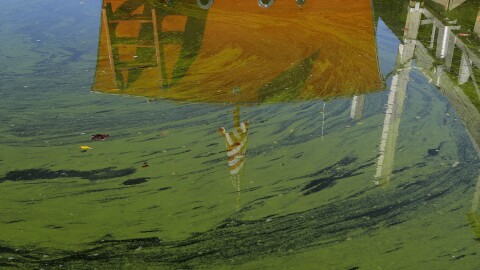Research into Lake Erie's toxic algae shows no clear decrease in the pollutants feeding the persistent blooms during the past five years, according to an Ohio Environmental Protection Agency report.
The review also finds that nearly all of the phosphorus and nitrogen flowing from Ohio's streams and rivers into the lake's western end is coming mainly from agriculture runoff.
The data backs up what environmental groups have been saying for years and what the head of the state EPA said last month: Voluntary steps farmers have taken to scale back the fertilizers feeding Lake Erie's massive algae blooms aren't enough.
Gov. John Kasich's administration now wants legislation that would require some farmers to make changes to reduce how much fertilizer and manure ends up in the lake.
Algae blooms, which can taint drinking water, sicken swimmers and harm aquatic life, have become a growing concern nationwide. In Ohio, harmful algae outbreaks have been found in rivers and inland lakes as well as Lake Erie.
The state EPA's study released this past week looked at how much phosphorus and nitrogen moves through the state's watersheds into both Lake Erie and the Ohio River.
The largest source, by far, of phosphorus and nitrogen going into the lake comes from the Maumee River watershed in northwestern Ohio, whose land is almost entirely in farm production. Both phosphorus and nitrogen are found in livestock manure and chemical fertilizers that farmers spread onto their fields to increase crop production.
Only once during the past five years has the amount of phosphorus dropped significantly in the Maumee watershed, the report showed. That was in 2016 during a dry year with few storms to wash farm fertilizers from croplands.
Otherwise the data showed that last year, the Maumee watershed had the highest amount of phosphorus over the past five years despite efforts to reduce runoff farms and other sources.
About 90 percent of the phosphorus and nitrogen from the Maumee watershed comes from what are called “non-point sources,” mainly farm runoff, the research showed.
Similar numbers were found for the Portage and Sandusky river watersheds that flow into the lake's western end, where the algae blooms have been concentrated.
Environmental groups have been calling on Ohio lawmakers and farmers to do more than expand voluntary practices and ban spreading manure and fertilizer on frozen and soggy fields.
The Ohio Farm Bureau Federation, the state's largest agriculture organization, believes more time is needed to judge the impact of the changes put in place just a few years ago.





